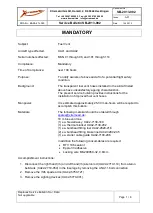
32
Section 09
Repairs, Inspections and Warranty
09
Repairs, Inspections and
Warranty
Type designation
SWING paragliders have an exact identification
on the centre rib, which is obligatory for all
paragliders. The information required is set out
in the airworthiness requirements.
It is helpful to provide the type designation of the
paraglider if you are contacting your SWING
dealer
with
any
queries
or
ordering
replacement parts or accessories, to ensure
accurate identification.
Repairs
SWING workshops
All repairs and servicing should be carried out
by a SWING authorised workshop or directly by
SWING. SWING workshops have trained staff,
original SWING parts and the necessary know-
how, all of which will ensure top quality.
Small repairs to the glider
You can repair small tears in the wing yourself
using self-adhesive sail material, provided that
the tears are in places which do not bear heavy
loads, are not at the seams and are no bigger
than 3cm. Single replacement lines for the
TWIN RS 2 can be ordered direct from us at:
The replacement of complete groups of lines
must be carried out by a SWING authorised
workshop.
Regular inspections
The following parts and materials must be
inspected regularly for damage, abrasion and
correct operation, e.g. after landing:
Risers and quick-links
Lines
Fabric
Lines
Measuring the length of the lines is part of the
regular paraglider inspection. The lines must be
measured with a load of 5kg, in order to ensure
reproducible results for a comparison with the
lengths in the check sheets. The line lengths for
the TWIN RS 2 are listed in the Maintenance
and Service book.
The lines have a considerable influence on flight
behaviour. Correct line length and symmetry
are also important for performance and
handling. Swing therefore recommends an
inspection every 50 to 100 hours or once a
year.
PLEASE NOTE
Environmental conditions such as high
temperatures or moisture can affect line
length. Check the line length regularly,
particularly if you notice any change in launch
or flight behaviour.
The line length should be checked if you have
landed in water or if the lines have got wet
through.
Lines age and lose strength even if the
paraglider is used infrequently or not at all. This
can affect the safety and function of your
paraglider. Signs of wear are slight bumps or
changes in flying characteristics. The lines must
then be replaced immediately. Use only
inspected and approved lines, which can be
obtained through SWING.
WARNING
A damaged line can result in loss of control
of the glider. Always replace lines which are
damaged.
If you need to replace damaged or worn-out
parts, use only original parts or approved
parts from the manufacturer.
WARNING
Do not under any circumstances use knots
to shorten the lines. Any knot will weaken the
line considerably and may cause the line to
break in case of high load.
The overhand knot and bowline knots
described are permitted only for connecting
the main brake lines/brake handle.






























